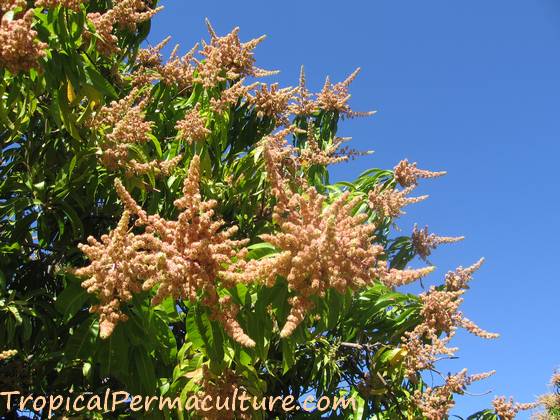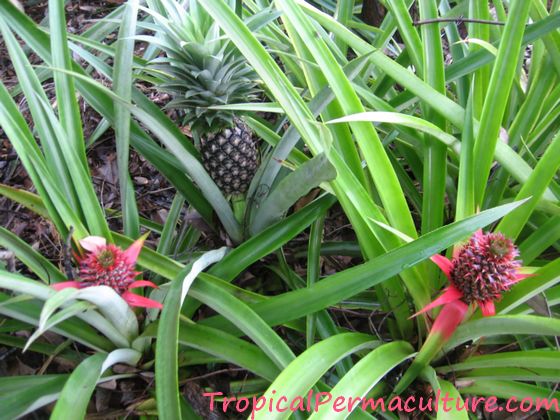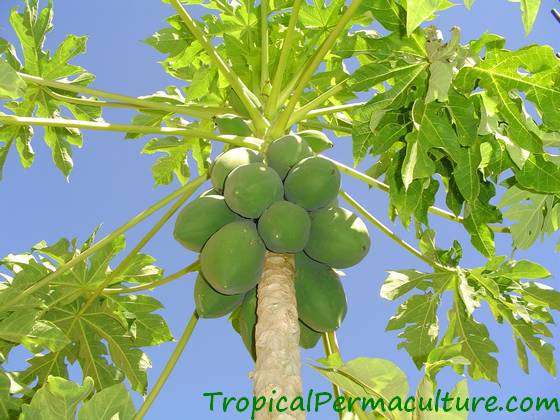Growing Bananas (Musa Spp.)
How To Grow Banana Plants And Keep Them Happy
Growing bananas does not take much effort, but it does require that you get a few things right when you first get started...
Banana plants can offer many benefits:
- They make great windbreaks or screens,
- they can keep the sun of the hot western side of your house,
- they utilize the water and nutrients in waste drains (think washing water or outdoor shower),
- the leaves can be fed to horses, cows and other grazers,
- the dried remains of the trunks can be used for weaving baskets and mats.
Oh, and they give you bananas. Lots of bananas!
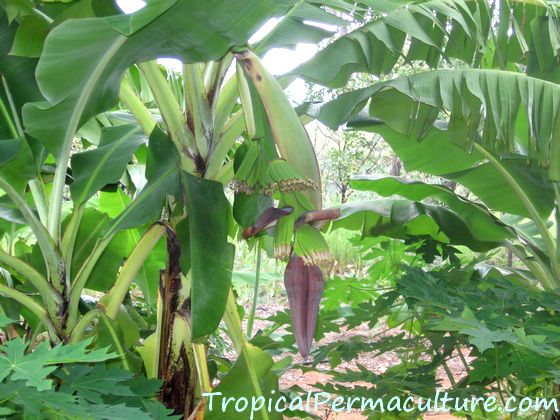 25 kg of bananas in the making.
25 kg of bananas in the making.
But when I look around friends' gardens then I see some pretty sad looking banana plants growing there. It helps to understand what bananas like and dislike if you want them to be happy!
Banana plants like:
- Rich, dark, fertile soils.
- Lots of mulch and organic matter. LOTS. Just keep piling it on.
- Lot of nitrogen and potassium. (Chicken manure!)
- Steady warmth, not too hot and not too cold. (Bananas are sissies when it comes to temperatures...)
- Steady moisture, in the ground and in the air.
- The shelter of other bananas! That's the most overlooked aspect by home growers...
Banana plants dislike:
- Strong winds.
- Extreme heat or cold.
- Being hungry or thirsty.
- Being alone and exposed.
More detail on all that below.
Banana Varieties
Cavendish is the variety that you know from the supermarket. If you live near a banana growing region, this is the variety you see in the plantations. It is a stout plant that produces large heavy bunches.
Lady Fingers are very tall and slender plants and have smaller, sweeter fruit. They are often grown by gardeners as ornamental plants with the small fruit being a bonus.
Plantains are cooking bananas. They are drier and more starchy. You use them green like you would use potatoes, and they taste similar.
80% of all bananas grown in the world are plantain varieties! They are an important staple food in many tropical countries.
There are many other exotic varieties, but those above are the most popular and most commonly grown.
What I describe below and most of the pictures on this page refer to Cavendish bananas but the advice applies to all other varieties as well.
How Do Bananas Grow?
Bananas are not real trees, not even palm trees, even though they are often called banana palms. Bananas are perennial herbs.
(Gingers, heliconias and bird-of-paradise flowers are distant relatives of bananas. They are in the same order, Zingiberales.)
Banana trunks consists of all the leaf stalks wrapped around each other. New leaves start growing inside, below the ground. They push up through the middle and emerge from the centre of the crown. So does the flower, which finally turns into a bunch of bananas.
Here is a picture series showing how the flower looks at first, and how the bananas appear and curl up towards the light.
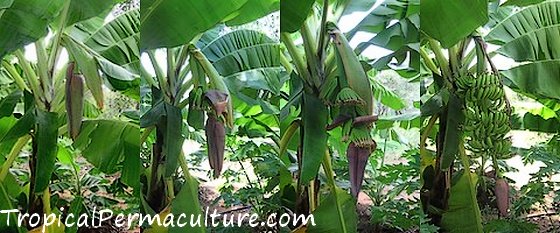
Those pictures were taken over the course of a few days. You can pretty much watch this happen. But now it will take another two months or so, depending on the temperature, for the fruit to fill out and finally ripen.
A banana plant takes about 9 months to grow up and produce a bunch of bananas. Then the mother plant dies. But around the base of it are many suckers or pups, little baby plants.
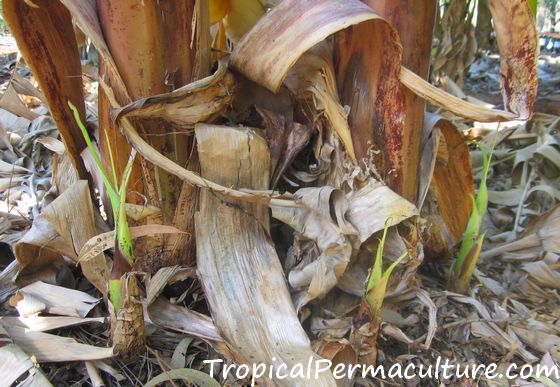
At the base of a banana plant, under the ground, is a big rhizome called the corm.
The rhizome has many growing points and those turn into new suckers/pups. The suckers can be taken off and transplanted, and one or two can be left in position to replace the mother plant.
Great, so now you know what to do once you have bananas growing in your garden, but how do you start?
How To Get Started Growing Bananas
First you need to make sure that you can in fact grow bananas where you are.
You need a tropical or warm subtropical climate. Bananas can handle extreme heat (if they have enough water), but they don't like it. They can handle cool weather for a short while, but they don't like that either. Below 14°C (57°F) they just stop growing.
If the temperatures drop any lower the fruit suffers, the skin turns greyish and the leaves can turn yellow. Frost kills the plant above ground, but the corm can survive and may re-shoot.
The ideal temperature range for banana growing is around 26-30°C (78-86°F).
You need a lot of water to grow bananas. The huge soft leaves evaporate a lot and you have to keep up the supply. Bananas also need high humidity to be happy.
Where I live the commercial banana growers water their plants two or three times a day with sprinklers to keep up the humidity in the banana plantation!
You need very rich soil. If you don't have good soil to start with, make some. Incorporate lots and lots of compost and plenty of chicken manure before you plant your bananas. Wood ash for extra potassium doesn't hurt either. Then mulch them very thickly. And keep mulching and feeding them!
And you need room so you can plant enough of them together. Bananas need shelter from wind. Growing many banana plants together increases the humidity in the middle, evens out temperature changes a bit, and it shades and cools the trunks. You don't want to cook the flower that's forming in the middle...
If you get a chance, look at a commercial banana plantation somewhere. The outside rows, especially the western side, always look sad. The best bananas grow on the inside.
You should plant bananas in blocks or clumps, not single rows and definitely not single plants. If you have very little room you can grow a few banana plants together and grow something else on the outside to protect them. But you do need to give them that sheltered jungle environment if you want them to be happy.
(Now, please don't send me any more emails letting me know that you are successfully growing a solitary banana plant in a tub on your patio or in your greenhouse or wherever. This is a permaculture site. We are not talking about keeping plants alive outside their natural growing conditions. We are growing food.
Having said that, understanding what makes a banana plant happy will help you grow it just for fun and under sub-optimal conditions as well.)
Planting Bananas
You can not grow the usual bananas from seeds. These banana plants don't produce viable seeds like wild bananas do.
The best way is to start with the above mentioned suckers or pups. Know someone who grows bananas? Talk to them. Every banana plant produces a lot more suckers than you need, so people usually have plenty to give away.
Only take suckers from vigorous banana plants. The suckers should have small, spear shaped leaves and ideally be about four feet high. Smaller suckers will take longer to fruit and the first banana bunch will be smaller.
Cut the sucker from the main banana plant with a sharp shovel. Cut downwards between the mature plant and the sucker. You have to cut through the corm. It's not easy.
Make sure you get a good chunk of corm and many roots with it. Chop the top off the sucker to reduce evaporation while you move it and while it settles into its new home.
Remember, the growing point is at the bottom of a banana plant. You can decapitate the sucker. It will grow back.
Another option is to dig up a bit of the rhizome and chop it into bits. Every bit that has an eye can be planted and will grow into a banana plant. But it takes longer than growing banana suckers.
Plant your bits or suckers in your well prepared banana patch, keeping two to five metres between them.
The spacing depends on your layout. My bananas grow in a block of several double rows. Within the double rows the spacing is two to three metres, now with two plants in each position, suckers of the initial plant. My double rows are four to five metres apart.
I also have a banana circle around an outdoor shower with two metres at the most between individual plants, and they are growing in a haphazard way.
If you have just a single clump of a few banana plants you can put them even closer together.
Keep your banana plants moist but not too wet in the early days or they may rot. They don't have leaves yet to evaporate water, so they don't need a lot of it.
Maintaining Your Banana Patch
The most common cause of death for bananas is lack of water.
The most common cause for not getting fruit is starvation.
Banana plants blow over in strong winds.
Protect them and feed them and water them and all will be well. Other than that bananas don't need much maintenance.
Just remove any dead leaves and cut down the dead plants every now and then.
You get bigger fruit if you remove all unwanted suckers, only keeping the best one.
After the initial planting you can leave two on healthy, vigorous plants. Beyond that it is better to keep one sucker per plant on average. Otherwise your patch will become too crowded.
The best suckers are the ones with the small, spear shaped leaves, NOT the pretty ones with the big round leaves!
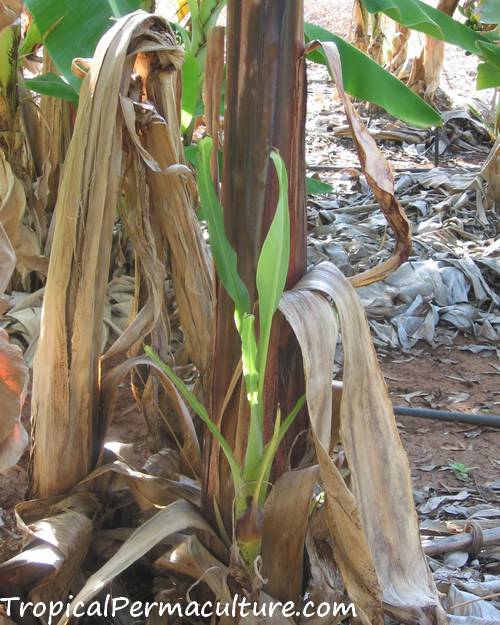
Why? A sucker that is still fed by the mother plant does not need to do much photosynthesis, so it doesn't need to produce big leaves.
And a sucker that is well looked after by the mother plant will produce better fruit and be stronger than one that had to struggle on its own.
A mature plantation is pretty much self mulching. Just throw all the leaves and old trunks etc. back under the plants. You can also grow other plants in the understory to produce more mulch. (I use cassava, sweet potato and crotolaria).
You just need to sprinkle on some fertiliser every now and then, to replace what you took out of the system when you took the bananas. Bananas are high in potassium, so ideally the fertiliser should be, too. Keep the fertiliser close to the trunk as bananas don't have big root systems.
Growing Banana Fruit
You may see your first flower emerge after about six months, depending on the weather. Leave the leaves around it, especially the one protecting the top bend of the stalk from sunburn!
As the purple flower petals curl back and drop off they reveal a "hand" of bananas under each. Each banana is a "finger".
You may get anything between four to a dozen or more full hands. Then, under the next petal, you'll see a hand of teeny weeny excuses for bananas. Those are the male fingers.
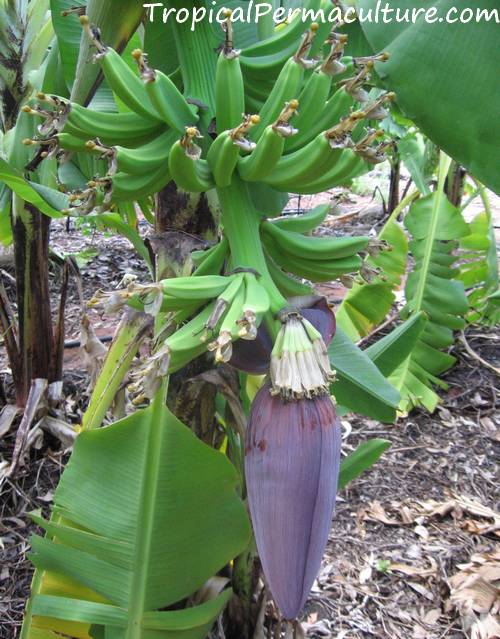
The male fingers just dry and drop off. Only the stalk remains. If you let it grow it will eventually reach the ground.
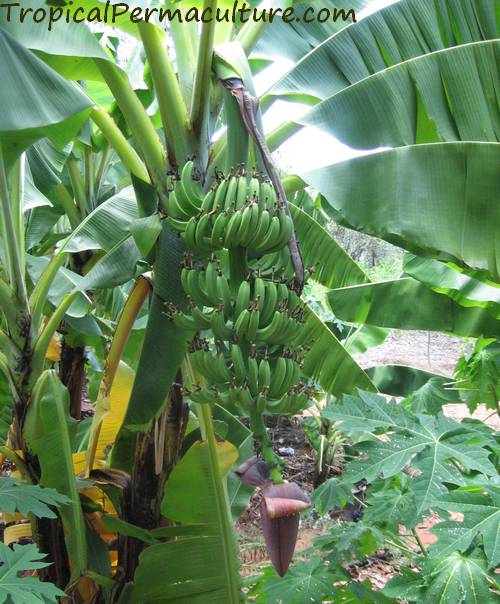
Some people break off the "bell" (the bunch of purple flower petals at the end) about 15 cm below the last female hand. That way the banana plant puts its energy and reserves into growing big bananas, and not into growing a long stalk. Commercial banana growers also remove some of the bottom female hands, so the remaining bananas grow bigger.
Not everyone thinks that way, though. This is a comment from one of my readers:
"I never cut the flower off the bananas. The hummers (Ed: hummingbirds) love them too much. As you said, there are always enough bananas around and though I sell them I have to keep my hummers happy."
Well, and then you patiently wait for at least another two months.
If your banana plant is not very strong or not very straight you may have to prop your banana bunch, because it becomes very heavy, and a bunch can snap off or pull the whole plant over.
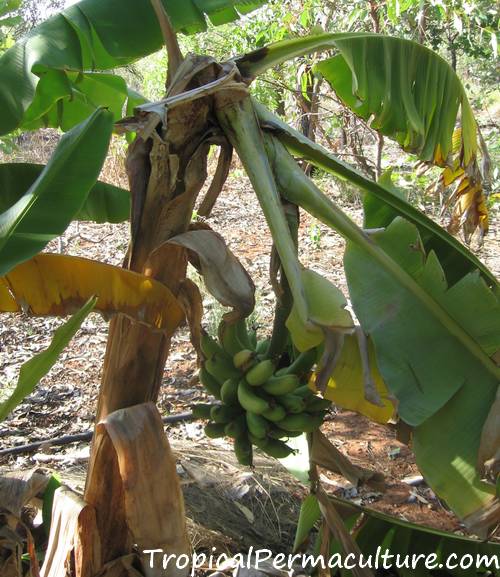
A good prop would be a long stick with a u-shaped hook at the end. But a long enough plank or pole can do the job, too. I leave that to your ingenuity.
Bananas are ready to be picked when they look well rounded with ribs, and the little flowers at the end are dry and rub off easily. You can pick them now, green, and they will start ripening as soon as you pick them, no matter their size.
They will eventually ripen on the bunch, too, and those bananas taste the best. But once they start they ripen very quickly, faster than you can eat or use them. So you may as well cut the top hands off a bit earlier and ripen them on the kitchen bench.
You can also cut the whole bunch and hang it somewhere if you need to protect it from possums or birds or other thieves. But then all bananas will ripen at once! So be prepared.
You can preserve bananas for use in cooking and baking by peeling and freezing them. Or, to preserve them for eating, peel, split in half lengthwise and dry them.
Once the bunch is picked the rest of the plant will die quickly. Cut it to the ground, throw on some chook poo, and let the next sucker grow while you process all the bananas.
The mystery of the missing banana bunch
by reader Glenn Baxter
"We grow some Cavendish bananas in a small area in the back garden and the biggest plant eventually produced a good-sized bunch of bananas.
The bunch was nearly ready to pick when all the hands disappeared off the main stalk. There were no skins or any bits of fruit left on the ground.
We suspected that someone had stolen them until we looked closer on the ground under the bare stalk...
There was a small mound of kanagaroo poo!
We didn't believe that the roos would eat bananas, until my wife was approached by one while she was eating a banana. She offered some to the roo who eagerly ate it and was looking for more. So there you go."
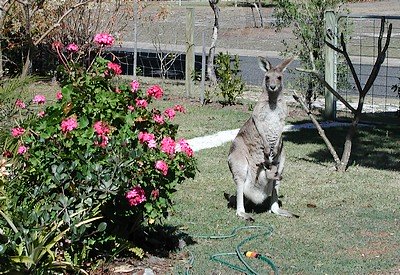 The banana thief! © Photo: Glenn Baxter
The banana thief! © Photo: Glenn Baxter
Commercial banana growers use bunch covers (plastic bags open at both ends that they slip over the bunch and tie at the top) to protect bananas from diseases, insects, sunburn and marauders. You can try to buy those bags at a rural supplies store, or beg some of a grower.
I used to bag my bananas (hard to get out of habits after four years of working on commercial plantations) but I don't bother any more. Even if the birds get a few, there are still more than enough left for me and the chickens and the dog and all friends and their families and freezing and drying... So why not let the wild birds (or kangaroos) partake of the bounty as well!
